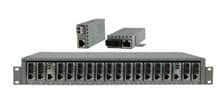- Products
- PoE Media Converters and Switches
- Ethernet & PoE Switches Product Selector
- Multi-Gigabit Ethernet and PoE Switches
- PoE PSE Commercial Switches
- PoE PSE Industrial Fiber Switches
- PoE Industrial Copper Extenders
- PoE Powered Media Converters
- PoE PSE Media Converters
- PoE Extenders & Injectors Product Selector
- Pluggable Transceivers Product Selector
- Product Lines

- iConverter Managed Multi-service Platform
- Copper to Fiber Media Converters
- Ethernet Media Converters
- 10 Gigabit Copper-to-Fiber
- 10/100/1000 Copper to 10 Gigabit Fiber
- 10/100/1000 Copper-to-Fiber with Integrated Management
- 10/100/1000 Industrial Copper-to-Fiber with Integrated Management
- 10/100/1000 Copper-to-Fiber with VLAN
- 10/100/1000 Dual Media Converter with VLAN
- Gigabit Copper-to-Fiber
- 10/100 Copper-to-Fiber with Integrated Management
- 10/100 Industrial Copper-to-Fiber with Integrated Management
- 10/100 Copper-to-Fiber with VLAN
- 10/100 Copper-to-Fiber
- Fast Ethernet Copper-to-Fiber
- Fast Ethernet Redundant Links
- 10Mbps Copper-to-Fiber
- 10Mbps Copper to Coax
- TDM Media Converters
- Serial Media Converters
- Ethernet Media Converters
- Fiber to Fiber Media Converters
- 10 Gigabit Fiber-to-Fiber Converter and Transponder
- 10 Gigabit Industrial Converter and Transponder
- SFP-to-SFP Fiber Converter and Transponder
- SFP-to-SFP Industrial Fiber Converter and Transponder
- Gigabit Fiber to-Fiber with 3 Rs
- 100/1000 Fiber-to-Fiber with 3 Rs
- Gigabit Fiber-to-Fiber
- Fast Ethernet Fiber-to-Fiber with 3 Rs
- Fast Ethernet Fiber-to-Fiber
- OC-3/STM-1 Fiber-to-Fiber
- OC-12/STM-4 Fiber-to-Fiber
- Carrier Ethernet Network Interface Devices
- CE 2.0 - 10G Demarcation NID
- CE 2.0 - 10G Demarcation and Aggregation NID
- CE 2.0 - 10/100/1000 Mult-port NID
- CE 2.0 - 10/100/1000 Mult-port NID with PoE
- CE 2.0 - 10/100/1000 8-Port NID
- SFP NID - Gigabit SFP NID
- microNID - 100/1000 compact NID
- CE 1.0 Service OAM - 10/100/1000 NID
- CE 1.0 Link OAM - 10/100/1000 Copper-to-Fiber NID
- CE 1.0 Link OAM - 10/100 Copper-to-Fiber NID
- CE 1.0 Link OAM - Gigabit Fiber-to-Fiber NID
- CE 1.0 Link OAM - Fast Ethernet Fiber-to-Fiber NID
- CWDM Multiplexers
- T1/E1 Multiplexers
- Ethernet Switch Modules
- Management System
- Chassis Options

- 1-Module Industrial Chassis

- RuggedNet Industrial Switches and Extenders
- Industrial PoE PSE Fiber Switches
- Multi-Gigabit Managed Industrial PoE+/BT Switches
- Multi-Gigabit Unmanaged Industrial PoE+/BT Switches
- 10G Managed 802.3bt PoE Switches
- 10G Unmanaged 802.3bt PoE Switches
- 10G Managed PoE+ Switches
- 10G Unmanaged PoE+ Switches
- 1G Managed PoE+ Switches
- 1G Unmanaged PoE+ Switches
- 1G Unmanaged 802.3bt PoE Switches
- 1G Managed 802.3bt PoE Switches
- Industrial Ethernet Switches
- Industrial PoE Copper Extenders
- Industrial Power Supplies

- OmniConverter Media Converter, Switches and Extenders
- PoE PSE Media Converters
- 10G Multi-Gigabit / Multi-Rate PoE Media Converter
- 10G Multi-Gigabit / Multi-Rate Media Converter
- 10/100 Multi-port PoE+ Media Converter
- 10/100 PoE+ Media Converter
- 10/100/1000 Multi-Port PoE+ Media Converter
- Industrial 10/100/1000 Multi-Port PoE+ Media Converter
- 10/100/1000 PoE+ Media Converter
- 10/100/1000 PoE++ 60W-100W Media Converter
- Industrial 10/100 Multi-port PoE+ Media Converter
- 1U Rack-Mount Shelf
- PoE PSE Compact Switches
- Multi-Gigabit Managed PoE+/BT Switches
- Multi-Gigabit Unmanaged PoE+/BT Switches
- 10G Managed 802.3bt PoE Switches
- 10G Unmanaged 802.3bt PoE Switches
- 10G Managed PoE+ Switches
- 10G Unmanaged PoE+ Switches
- 1G Managed PoE+ Switches
- 1G Unmanaged PoE+ Switches
- 1G Managed 802.3bt PoE Switches
- 1G Unmanaged 802.3bt PoE Switches
- Ethernet Switches
- PoE Copper Extenders
- Single Pair Ethernet Converters
- PoE Injectors

- miConverter Unmanaged Miniature Media Converters
- 10/100/1000 Copper-to-Fiber
- Industrial 10/100/1000 Copper-to-Fiber
- 10/100/1000 Ultra-Compact Copper-to-Fiber
- Gigabit Copper-to-Fiber
- 10/100/1000 Copper-to-Fiber PoE Powered
- 10/100 Copper-to-Fiber
- 10/100 Ultra-Compact Copper-to-Fiber
- 10/100 Copper-to-Fiber PoE Powered
- 18-Module Chassis
- Industrial 10/100 Copper-to-Fiber PoE Powered

- FlexSwitch Compact Switches
- Solutions
- Company
- Support
- How to Buy
STP vs RSTP vs MSTP: What Is the Difference?

When it comes to network design, ensuring reliability and preventing loops are crucial aspects of creating robust communication systems. Spanning Tree Protocol (STP), Rapid Spanning Tree Protocol (RSTP), and Multiple Spanning Tree Protocol (MSTP) are essential standards in network topology to achieve these goals. Each protocol has unique features and use cases, making it vital to understand their differences. In this article, we’ll explore these protocols in-depth and answer the key question: What is the difference between STP, RSTP, and MSTP?
Understanding Spanning Tree Protocol (STP)
What Is STP?
The Spanning Tree Protocol (STP) is a network protocol that ensures a loop-free topology in Ethernet networks. Developed in the 1980s, it creates a single spanning tree for a network, selectively disabling redundant paths to prevent data loops.
Key Features of STP
- Loop Prevention: Detects and disables redundant paths in the network.
- Convergence Time: Takes 30-50 seconds to converge after a topology change.
- Protocol Standard: Defined in IEEE 802.1D.
How STP Works
STP operates by electing a root bridge in the network. All decisions regarding path selection are based on the root bridge. The protocol uses Bridge Protocol Data Units (BPDUs) to communicate and determine the shortest path to the root bridge. Redundant paths are placed in a blocking state to prevent loops.
Limitations of STP
- Slow convergence time, making it less ideal for modern, dynamic networks.
- Limited scalability for larger networks.
- Increased likelihood of temporary network disruptions during topology changes.
Rapid Spanning Tree Protocol (RSTP)
What Is RSTP?
Rapid Spanning Tree Protocol (RSTP) is an enhancement of STP designed for faster convergence. Introduced as part of IEEE 802.1w, it builds upon STP’s principles while addressing its shortcomings.
Key Features of RSTP
- Rapid Convergence: Typically converges in less than 10 seconds.
- Port Roles and States: Introduces new port roles (e.g., alternate, backup) and simplified port states.
- Backward Compatibility: Can interoperate with legacy STP networks.
How RSTP Works
RSTP refines the BPDU process by allowing switches to immediately move ports to a forwarding state under certain conditions. The introduction of alternate and backup port roles ensures a more streamlined process for detecting and responding to topology changes.
Advantages of RSTP
- Faster recovery from network changes.
- Simplified configuration and improved efficiency.
- Enhanced reliability and reduced downtime.
RSTP Use Cases
- Suitable for medium-sized enterprise networks.
- Ideal for environments where quick failover is critical.
Multiple Spanning Tree Protocol (MSTP)
What Is MSTP?
Multiple Spanning Tree Protocol (MSTP) extends RSTP to manage multiple spanning trees across different VLANs. Defined in IEEE 802.1s, MSTP allows for greater flexibility and scalability in complex network environments.
Key Features of MSTP
- Multiple Instances: Enables multiple spanning tree instances mapped to VLANs.
- Optimized Resource Usage: Reduces the number of spanning trees, conserving resources.
- Interoperability: Compatible with STP and RSTP.
How MSTP Works
MSTP groups VLANs into regions, with each region supporting multiple spanning tree instances. By associating VLANs with specific instances, MSTP optimizes network performance and simplifies management. Each instance operates independently, allowing for efficient load balancing and fault isolation.
Advantages of MSTP
- Scalable for large networks with numerous VLANs.
- Reduces overhead by grouping VLANs into regions.
- Improved traffic load balancing.
- Enhanced fault isolation and network segmentation.
MSTP Use Cases
- Ideal for large-scale enterprise or service provider networks.
- Efficient management of VLANs in multi-tenant environments.
Key Differences Between STP, RSTP, and MSTP
| Feature | STP | RSTP | MSTP |
|---|---|---|---|
|
Convergence Time |
30-50 seconds |
<10 seconds |
<10 seconds |
|
Standard |
IEEE 802.1D |
IEEE 802.1w |
IEEE 802.1s |
|
VLAN Support |
Single instance |
Single instance |
Multiple instances |
|
Scalability |
Limited |
Moderate |
High |
|
Use Case |
Legacy networks |
Medium-sized networks |
Large, complex networks |
Advantages of Using These Protocols
STP Advantages
- Straightforward implementation.
- Essential for older network setups.
- Proven reliability in legacy systems.
RSTP Advantages
- Improved performance over STP.
- Faster failover ensures minimal disruption.
- Backward compatibility offers flexible deployment.
MSTP Advantages
- Scales effectively for large networks.
- Optimizes resource usage and supports modern network architectures.
- Enhances network performance through VLAN grouping.
STP and RSTP States: Key Concepts
Understanding the states of STP and RSTP is critical for network optimization. STP’s states—blocking, listening, learning, and forwarding are slow compared to RSTP’s faster role-based transitions. RSTP’s alternate and backup ports enable efficient standby configurations.
How to Choose the Right Protocol
Selecting the right spanning tree protocol depends on several factors:
- Network Size: For small networks, STP may suffice, while MSTP is best for large-scale networks.
- Performance Requirements: If rapid recovery is critical, RSTP or MSTP should be considered.
- VLAN Management: MSTP is ideal if you manage multiple VLANs.
- Existing Infrastructure: Ensure compatibility with existing network devices and protocols.
- Future Scalability: MSTP is better suited for networks expected to grow significantly.
Practical Applications of Spanning Tree Protocols
Spanning Tree Protocols find applications across various industries and network setups. From simple office networks to large-scale data centers, understanding which protocol fits best can significantly enhance efficiency and reliability.
- Small Business Networks
For small businesses with limited infrastructure, STP offers a reliable, cost-effective solution to prevent loops. Its slower convergence is often sufficient in these environments where topology changes are minimal.
- Enterprise and Multi-VLAN Environments
Enterprises managing multiple VLANs benefit greatly from MSTP. Its ability to segment traffic and reduce network overhead makes it a go-to choice for ensuring smooth operations across complex setups.
Future Trends in Network Protocols
The evolution of spanning tree protocols continues to align with advancements in network technology. Automation, software-defined networking (SDN), and improved scalability are shaping the next generation of network solutions.
- Integration with SDN
Protocols like MSTP are being increasingly integrated into SDN frameworks, providing enhanced control and flexibility. These integrations allow for dynamic adjustments to network topologies and improved fault management.
- Increased Emphasis on Convergence
With modern networks demanding real-time adjustments, protocols with faster convergence times, such as RSTP and MSTP, are expected to become standard. This trend emphasizes the need for ongoing updates to existing infrastructure.
Frequently Asked Questions (FAQs)
1. What Is the Main Purpose of Spanning Tree Protocols?
Spanning tree protocols prevent loops in Ethernet networks by creating a loop-free logical topology. They ensure efficient data transmission and avoid broadcast storms.
2. How Does RSTP Achieve Faster Convergence Than STP?
RSTP introduces new port roles and states, such as alternate and backup ports, which allow faster detection and response to topology changes. This reduces convergence time to less than 10 seconds.
3. Can MSTP Be Used with Legacy Devices?
Yes, MSTP is backward-compatible with STP and RSTP. However, legacy devices might limit the benefits of MSTP’s advanced features.
4. Why Is MSTP Better for Large Networks?
MSTP supports multiple spanning tree instances, enabling efficient management of VLANs and reducing resource usage. This makes it highly scalable for large and complex networks.
5. Is RSTP Always the Best Choice Over STP?
While RSTP offers faster convergence, STP may still be sufficient for smaller, less dynamic networks. The choice depends on specific network requirements and performance needs.
Final Thoughts
Understanding the differences between STP, RSTP, and MSTP is essential for designing a reliable and efficient network. Each protocol serves unique purposes, and the right choice depends on the size, complexity, and performance requirements of your network.
For professional guidance on implementing the best spanning tree protocol for your network, contact Omnitron Systems today. Our team of experts can help you design scalable, secure, and efficient networking solutions tailored to your needs.









